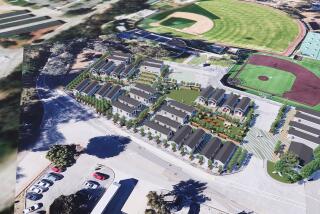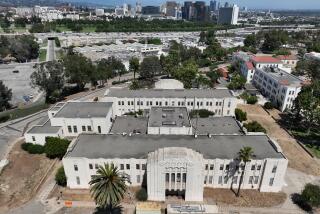Sides Draw Up Battle Lines Over Korean War Memorial Proposal
A proposal for an International Korean War Memorial has prompted a war of sorts in San Pedro.
The battle lines have been drawn over the last two weeks:
- A meeting to resolve the dispute turned into a shouting match between veterans who back the memorial, proposed for Angels Gate Park, and residents who oppose it.
One resident claimed that the veterans--some of whom live in San Pedro--”acted like bullies.” A veteran accused residents of having “a closed mind.” Said Mario Juravich, an aide to Councilwoman Joan Milke Flores: “We had a war, almost.”
- A residents’ group has formed for the sole purpose of fighting the monument. Although some of its members do not want it at Angels Gate, others oppose only the design, which depicts a dozen 10-foot-high bronze soldiers in battle.
“It’s really violent, it has all these guns in it,” said the group’s leader, Richard Karl. “It’s very inappropriate for a peaceful place like Angels Gate Park.”
- The International Korean War Veterans Memorial Committee, which is proposing the monument, unveiled a model of the bronze sculpture last Saturday, and the committee’s executive director said its design is “not negotiable.” He said he expects ground-breaking to proceed as planned, on June 25.
- Los Angeles Mayor Tom Bradley, who initially offered the five-acre Angels Gate site to the veterans, has reaffirmed his backing for the project despite the swelling controversy. The mayor “supported the project from the beginning and he is still supporting it,” an aide said Wednesday.
- The city Department of Recreation and Parks, recognizing the opposition, has extended its comment period on the project, giving citizens until April 5 to air their views.
At the center of all the controversy is a plan for a $4-million complex that will stand on a promontory overlooking the Pacific, adjacent to the Korean Friendship Bell. It will honor “silent veterans of the Forgotten War,” according to the memorial committee, which has raised about $1.6 million so far.
The proposal calls for an open space with the bronze battle sculpture in the center. The sculpture would rest atop a base of rock and granite that, according to the committee’s literature, will be taken “from the very battlefields of Korea that they (the soldiers) died defending.”
The 24-foot-high centerpiece will be ringed with the flags of 22 nations that participated in the conflict. The plan is to light the monument until 10 p.m. and light the flags around the clock. That is another point of contention among residents.
Role of Flores
Although the outcome of the conflict in San Pedro remains unclear, it will no doubt depend--at least in part--on the recommendation of Flores.
The councilwoman has no formal say in the matter, but her opinion will carry weight when the city Recreation and Parks Commission decides whether to approve the memorial. Although Bradley offered the land to the veterans, the commissioners--who are appointed by the mayor--will make the final decision.
Flores has expressed two major reservations about the memorial: She does not like the word “war” included in its name, and she does not want it to overpower the bell and its large pagoda. She does not object to the sculpture’s design, however. “It’s a fact of life that there was a war,” she said, “and this will depict that.
“I personally don’t have any problem with the monument itself,” she said. “I’m not so sure about the size, but it seems to me that if the size could be adjusted to fit without being obtrusive in the community, then I wouldn’t have any problem.”
Will Follow Constituents
In the end, the councilwoman said, her opinion does not really matter because she will do what the majority of her constituents want. So far, she said, most people she has talked to favor having some sort of memorial at the site.
However, she expects the organizers of the memorial effort to be willing to compromise. “If the organizers are saying, ‘It’s our way or no way,’ then it will probably end up no way.” she said.
Jack Stites, executive director of the International Korean War Veterans Memorial Committee, said his group is indeed willing to compromise--about everything except the design of the sculpture. The group has already changed the design once. After city officials informed them that their plans for a 40-foot monument exceeded height limits in the area, they scaled it down.
However, Stites did say that he would “welcome the help” of residents who have suggestions for the design of the setting for the monument.
Stites’ committee is an outgrowth of a group that calls itself the Chosin Few. All are survivors of the battle at Chosin Reservoir, in which about 3,000 American, British and South Korean soldiers died, along with an estimated 25,000 Chinese troops.
The battle began in the last week of November, 1950, when Chinese troops attacked United Nations forces as they approached the Chinese border from North Korea. China’s entry into the war began a long retreat of United Nations forces, which had taken control of North Korea after the North’s invasion of the South five months before. The scene in the monument is modeled after the veterans’ remembrances of the reservoir battle.
The Chosin Few initially proposed placing the monument in Washington, and took the idea to the American Battle Monuments Commission, an independent federal agency that oversees military cemeteries and monuments.
“When they came to talk to me,” recalled Army Col. William E. Ryan, the commission’s director of operations and finance, “it was a Marine Corps memorial to the Battle of the Chosin Reservoir. It hadn’t gotten to be an international Korean War memorial at that time.”
Ryan said he told the group that his agency had been pressing for more than a decade--unsuccessfully--to get the federal government to authorize a national memorial to all veterans of the Korean War. With limited public space available in Washington, he said, he thought chances were slim that Congress would approve a memorial for the Chosin Few, particularly when a national memorial had not yet been approved.
Stites said his group was discouraged after the Washington meeting, and decided to look elsewhere. After embarking on a national site search and considering locations in New Orleans, San Diego and elsewhere, it recruited sculptor Felix de Weldon, who created the Iwo Jima Monument in Washington.
In 1986, Bradley offered the group five acres at Angels Gate Park, just south of the Korean bell, which was given to the city by South Korea in 1976.
In the following year, Congress approved the national memorial, which will be located in Washington, across the Mall from the memorial to Vietnam veterans. A national competition is under way to select the design of the Washington monument.
There was no competition for the design of the San Pedro memorial--another point of contention among some residents. At some point, De Weldon--who provided city officials their first glimpse of how the bronze sculpture would look--was replaced by sculptor Terry Jones, who specializes in battle sculpture. Jones’ design for the sculpture was unveiled last Saturday.
Meanwhile, since Bradley first offered the land in 1986, the proposal for the San Pedro monument has quietly moved through the city bureaucracy. The city Department of Cultural Affairs has approved the monument, and recreation and parks officials have issued a “negative declaration” for the project--a document that says the monument, in effect, will not harm the environment.
The recreation and parks commissioners also gave tentative approval to the project, based on conceptual designs.
But after the controversy erupted at a recreation and parks public hearing in December, Flores asked the committee to reconvene, examine the pros and cons of the monument and make a recommendation to her.
More to Read
Sign up for Essential California
The most important California stories and recommendations in your inbox every morning.
You may occasionally receive promotional content from the Los Angeles Times.










